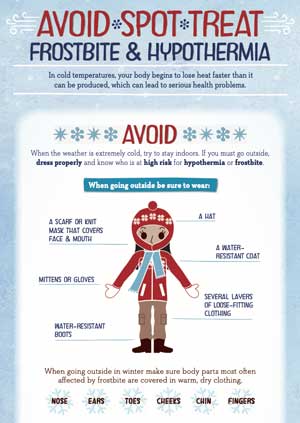When temperatures drop, this risk rises

Jack Frost nipping at your nose sounds charming in a Christmas song, but the less jolly version is that it could be putting you at risk of frostbite.
Brief outings into the cold aren’t very risky, but people who are outside for extended time in the winter should be aware of the warning signs of this potentially serious condition.
“The duration of exposure to freezing temperatures is the number one issue,” said Michael J. O'Connell, DO, a specialist in emergency medicine who practices at Falmouth Hospital. “Mostly it's going to affect people who have to be outside for work. The others at risk would be those who are outside voluntarily, such as winter sports enthusiasts, who spend too much time exposed and/or are not dressed appropriately.”

Avoid Frostbite & Hypothermia [PDF]
For additional information on frostbite and hypothermia, download this helpful infographic from the Centers for Disease Control and Prevention (CDC).
Download
What is frostbite?
Frostbite is an injury that occurs when skin and underlying tissue freeze. What happens next can be the real cause of damage.
“When you start thawing the frozen tissue, it releases this tremendous inflammatory cascade,” said Dr. O’Connell. The blood vessels constrict, leading to thrombosis (clots blocking blood flow) and preventing oxygen from getting to the tissue. In the worst cases that leads to the tissue dying.
“This is most likely to happen in the fingers and toes, but it can occur in the ears, nose and other parts of the face,” he said.
“It has to be below freezing, with or without windchill, for your skin to freeze. If the wind's really whipping, that's going to increase your heat loss tremendously.”
Cold-weather precautions
If you’re going to be outside for an extended period in sub-freezing weather, you can take some basic precautions. Dress in layers, but be sure the clothing is not constrictive, which could decrease blood flow. This also can protect you from hypothermia, he said. The base layer of clothing should be a wicking layer to keep your skin from becoming moist, which can cause additional heat loss, he added
“Wear two pairs of socks and make sure you have good gloves. Protect your face as much as possible. There’s been some talk about using protective ointments, but that is not helpful. In fact, it's moisture, so it may actually make things worse.”
Warning signs
The first warning signs of frostbite are stinging, burning or numbness. “The way it's described in textbooks is like that feeling you get when your foot falls asleep when you've been laying on it too long,” Dr. O’Connell said. “It hurts, but it kind of tingles. That's a sign from your body that something's not right.”
The lack of blood flow also causes color changes in the skin, making it look pale or waxy. You might have difficulty bending your fingers.
If you notice those symptoms, you should get inside to a warm area. Don’t rub the affected area, but try to get warm slowly.
“If it's your hands, put them in warm water for 15-20 minutes and then see what's going on,” Dr. O’Connell said. “If you start getting blisters or things aren't improving over that first rewarming phase, that's when I'd probably go see a doctor. The full extent of the injury may not be revealed for many hours or days.”
One more tip: avoid drinking alcohol if you’re going to be out in the cold, he said. “It's kind of a double whammy because, number one, alcohol is a vasodilator, so it makes you more prone to heat loss. Second, you're probably not making the wisest decisions when you're drinking, so you may not recognize some of the signs and symptoms. You may make poor judgements and stay outside longer than you should or wear inappropriate clothing, or just miss the key indicators that you're getting cold.”
